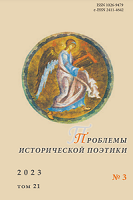Мифологема горы в алтайском тексте русской литературы
The Mythologeme of the Mountain in the Altaic Texts of Russian Literature
Author(s): Tatiana A. BogumilSubject(s): Regional Geography, Russian Literature, 19th Century, Theory of Literature, Sociology of Literature
Published by: Петрозаводский государственный университет
Keywords: mountain anthropology; mountain literature; Siberian text; image of Altai; Gorny Altai; Caucasus; Athos; Belukha; world axis; initiation; labyrinth; Ark; Grail; Macarius; A. P. Kaigorodov;
Summary/Abstract: The article provides an overview of scientific sources regarding mountain literature related to the Russian Altai. Descriptions of alpine land- scapes written by travelers of the 19th century included realities of the area, analogies with foreign geographical objects (the Swiss Alps, the Lebanese Range, the Caucasus), with a different kind of artistic discourse, i.e., painting, with a different type of world order, i.e., terra incognita. In 19th century journalism the motif of spiritual transformation and miracle appeared (Altai = Athos), turning out to be especially in demand in Orthodox literature at the turn of the 20th century. Soviet literature desacralized the Altai cult of the mountains and the Master of Altai, previously represented mainly in ethnographic literature. Since the 1960s, there has been a growing trend of neo-mythologization of the Altai mountains. The paper reveals the semantics of the mountain mythologem in the context of the Altaic text of Russian culture on the example of V. N. Tokmakov’s novel “Dance of the Little Kings.” The neo-romantic world of the work is divided into two realities: fictitious (the capital) and real (Altai as an earthly projection of the otherworldly White Mountain). The significance of the Mountain in the novel is built on universal mythological motifs associ- ated with this mythologem (the locus of the battle between Good and Evil, the global flood, hidden treasures, a labyrinth-cave as an anti-mountain, initiation, an analogy with a tree, a man, a book, etc.). The author managed to create an original image of the mountain using a unique combination of these motifs, their historical-geographical and fantastical content.
Journal: Проблемы исторической поэтики
- Issue Year: 21/2023
- Issue No: 3
- Page Range: 261-280
- Page Count: 20
- Language: Russian

